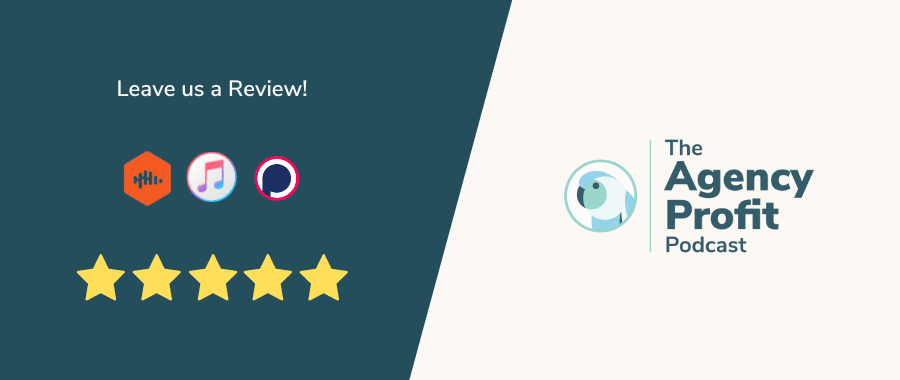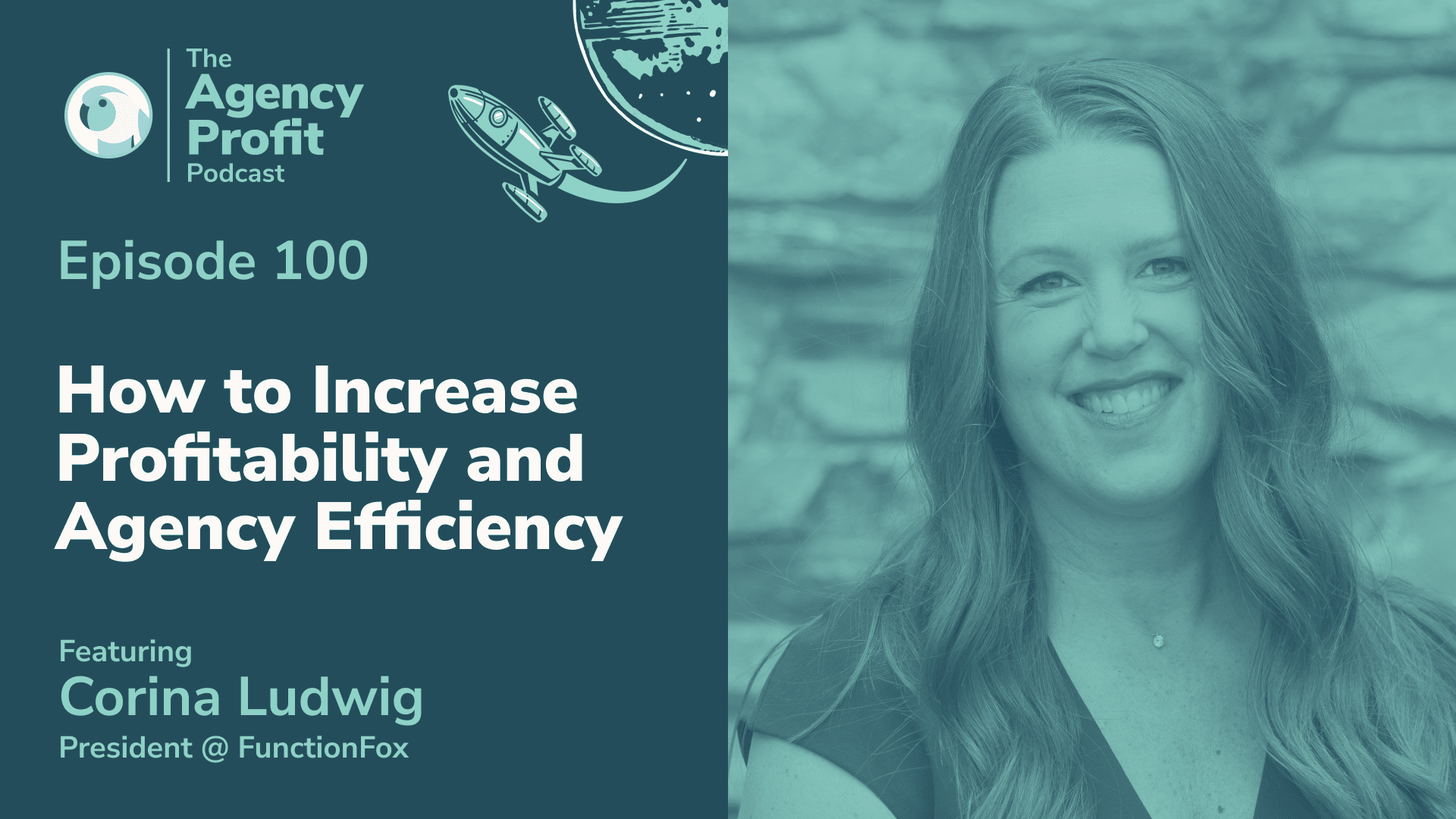This week, Corina Ludwig joins us to talk all things agency time and financial management. What could agencies be doing better in terms of time and financial MGMT to help increase client business while maintaining internal employee satisfaction? Corina will chart some of the top trends she’s seeing across agencies FunctionFox work with that result in increased profitability.
About Corina Ludwig
Corina Ludwig is the President of FunctionFox – the undisputed leader in Timesheet and Project Management Software for creative professionals worldwide. Now in its 22nd year, FunctionFox aids clients with productivity, profitability, and workflow management.
Whether it’s helping them get set up and track their clients, projects, and their staff, or increasing their agency time and financial project management, all the way through to best practices – by helping them to improve their workflow Corina helps them make more money.
In her free time, she spends time with her husband and three Great Danes and runs a successful culinary business!
Points of Interest…
- Agency trends Corina has witnessed 3:11
- Requirement for Integrating Payroll and Finance 8:29
- Time Management and Project Management 12:46
- Workflow Management 18:54
Agency Trends Corina Has Witnessed
The agency world has changed A LOT in the last 22 years. The way that you must run an agency today – alongside the pressures and the dynamics in the market – is very different than what they looked like 20 years ago.
Given Corina’s ample insight, what are the key market shifts she has witnessed over the last two decades, some of the current trends spanning the diverse set of clients FunctionFox works with?
“Some things have stayed the same, while there is an ebb and flow of things that shift – like real estate – sometimes it’s a buyer’s market, sometimes it’s a seller’s market. It’s the same thing in the advertising industry. One of those things that ebb, flows, and shift over time are agencies doing the work in-house versus hiring external agencies.”
As for where that stands in the current market; Corina sees work taking place more inhouse at this time. Why is that? Well, clients love seeing the transparency – specifically with timesheets, which brings greater value, and greater transparency overall. As for what has stayed consistent? In Corina’s experience, billable hours have always been important. At the end of the day, you know, the agencies need to make money, but that percentage has increased.
“I think where people were happy with 40 or 50% billable time, now it’s 65, 70% billable. Most are striving for a higher number for financial freedom. And, again, that comes back to timesheets.”
Other trends include increased Technology, in terms of the tools being used, plus all the different channels now available – It’s an advertiser’s dream in terms of channels to work with. However, it can also be a bit of a nightmare because you have to absorb all those different channels and then figure out cross-promotion.
Indeed. In my experience, It used to be that time materials was what everybody was doing. Now, we’re seeing smaller agencies taking on more complex facets. These include pricing models and staffing models, with a fluid mix of in-house teams – alongside freelancers and white-label partners. There is so much more downward pressure on margins, ***something we expand upon from the 6:00 minute mark***
Requirements for Integrating Payroll and Finance
When it comes to the first pillar, that being payroll and finance, I ask Corina to outline some of the key requirements that agencies should be thinking about as they evaluate how to get that set up within in their business?
“The most important thing is that it’s clear for whoever the accountant is on how to track what they need to track. Equally important is that it can grow with your business. Be it QuickBooks, Sage, or Simply Accounting – any of those can scale with your business. It’s easy to input staff details and update them given most of them are integrated with other programs.”
Even if they’re not integrated, that’s okay. Why? Because the accounting can really function on its own – if you can put or import the right information into it. Therefore, for all intent and purposes, it can function as a standalone, and – in Corina’s experience – there are some positives to that.
“We sometimes recommend that it’s standalone because then it’s completely unattached to any other employees. That sometimes that gives some trust to their employees. This is a pillar I would start with, while also ensuring it’s something that’s scaleable for your business.”
It’s alarming to me just how many people will hire a new firm, set up QuickBooks, etc, and then I ask them “What goes into this chart of accounts bucket? How do you accrue your revenue?” To which they often respond “I don’t know, my accountant just does it.” To be clear, these are not hard conversations to have in order to have key oversight over your business. If you are doing accrual revenue recognitionSome of the conversations you should be having include…
- What is your accounting team looking at to understand how much revenue to accrue for each client?
- How are you defining things like pass through expenses; delivery expenses; sales and marketing versus admin?
Did you know that we have some great resources on this here blog to help identify how to isolate those things? Shameless self promotion aside; a little bit of thought can go a really long way in ensuring that the required data is very clean and useful going forward. Think about it, since you’re going to be making the investment to do that stuff anyway, you might as well do it just a little bit better. ***Corina expands on this, and important conversations around business goals, from 10:30***
Time Management and Project Management
The beautiful thing about finance data is it’s precision, it’s so detail orientated. Everything must go through finance data and get reconciled in all your invoices. That said, the challenge is getting it to be yet more detailed in terms of milestones, or deliverables, or client insight. This additional precision can become costly. A direct result of that is, typically, finance data can be found lagging. For most people, it’s a monthly cadence – it might be 15-to-20 days after the month in question before you actually gain visibility into what’s happening in your business.
Side note: if you’ve got a process for how you go about defining your scopes for projects, it’s best that you install a regular cadence to review and tweak these numbers based on past performance as time goes on. The Agency Profit Toolkit is a free resource that has meeting templates that you could directly apply to this, among other goodies. Grab your copy below!
Enter Time and Project Data! This can be super useful – it can give you a slightly less precise but generally very accurate view into what’s happening in the business on much tighter time horizons. As a plus, it usually tends to be far less expensive. I nerd out on this from ***13:40 minutes*** before asking Corina of her thoughts on Time Management and Project Management.
What are the keys to Time Management and Project Management? What should agencies be thinking about when they’re looking at their tooling and their requirements there?
“Everyone wants to be perfect in this regard, and everyone knows that they could be better – but start with where you’re at. And don’t try to do it all at once. Focus on one thing; try to look at one client and ask, ‘Okay, are we on track? Are we better than we were last month?'”
Sage advice from Corina. Do NOT try to do everything across the board because it’s really difficult. However, waiting for your accountant, or your month end financial reports, 10, 15, maybe 20 days (aiming for eight-to-10 is always preferable) after said month, then, it’s too late at that point.
If your aim is to spot trends, then it’s workable, but if you’re looking to make actual decisions based on that data, it’s too late. This is where the time tracking and project management, if set up in the optimum way, can result in your ability to pull the necessary reports on a weekly, and even daily, basis.
“It’s setting it up by project for each client. It’s setting up, you know, what are the billable rates for each of the staff? Are you profitable? You can set up that profitability and say, ‘Okay, you know, are we at target? Are we over target or under?’ And it’s making those adjustments in real time.”
***Corina talks scope creep, overservicing, benchmarks, and percentage targets from 15:28***
Workflow Management
Okay, we’ve, got some tracking. We’re starting to see that we’re not performing at the level we want. Maybe our utilization is not quite as high, or we’re noticing that we’re over servicing clients. Perhaps we’re just looking at financials and it’s like, “Hey, our delivery margin’s not that great!”
What are some of the key levers that Corina sees clients being able to pull in order to get things back on track? What should you dear listeners/readers be thinking about?
“There’s so much complexity in that and there’s so many variables. I think it comes down to a few things. Firstly, HR; do you have the right people in the right seat doing the right things? You can put a junior person in a spot that’s gonna take them three or four times as long. You may think you’re getting it cheaper, but really, you’re not.”
In terms of workflow and overall agency time and financial management, you need to consider…
- Firstly, always look at the human factor and the impact it has.
- Secondly, determine if you’re niche focussed. Are you taking on projects that are outside of your usual realm and therefore increasing time spent as it’s outside of your wheelhouse. This could have a direct impact on the financial success of that particular project or client.
- Thirdly, if you’re doing projects that your team is excited about, that promotes optimum flow. Aligning the right set of clients and the right mix of projects, while spending the right time on the right projects with the right people, is extremely tricky, however. That’s where accountability comes in.
Agency workflow is about timing your projects correctly; ensuring you have enough to keep your team busy and engaged, while also giving them enough time to have the creative flexibility to really give and deliver their best work. This comes down to your Project Manager and the Traffic Manager to oversee the right workflow so the team can be as productive, engaged, and results focused.
Or, as we at Parakeeto put it: “The data can only tell you what the data is, but it can’t tell you why the data is.” That’s why it’s imperative to use your data to have pivotal conversations. ***More from 21:18***
Key Takeaway
Most accountants are not in the business of projecting the information you’re gonna want to see and then architect your data to do that. Therefore, it’s really important for you – as the client – to be clear with them about your objectives. The data has to get set up at the start for that objective in mind; it’s nigh impossible to go back and somehow start tracking things that you weren’t tracking before.
Secondly, when it comes to Time and Project Management, it’s imperative that you start simple and then build on that foundation. All too often, myself and Corina see the time where people are conflating precision and accuracy. You don’t need to know the amount of time that it took to complete this sub-task, within a task, within a deliverable, within a milestone, etc. You want to avoid operational drag ***scoot to 16:32 minutes for additional details***
In short, don’t get bogged down in the sub-task tracking; Corina recommends staying at higher level for bigger results, and bigger shifts. Once you achieved that, and there’s nothing else to improve upon, THEN you can add some more complexity to proceedings and dive down a little deeper.
***To get a better handle on the more functional part of measuring your performance, see Corina’s closing comments from 22:54***
See more from Corina…
- Corina’s LinkedIn linkedin.com/in/corinaludwig
- FunctionFox LinkedIn linkedin.com/company/functionfox-systems
- FunctionFox Twitter twitter.com/functionfox
- FunctionFox FaceBook facebook.com/functionfox
Did you learn anything new from this episode? Let us know in the comments below! We have helpful blogs designed to bolster your agency profitability, such as How To Calculate Your Billable Employee Cost-Per-Hour.
Our next installment of #APP, on November 30th, will see Marcel chat with Brad Farris for our 101st edition! Our previous blog – Episode 99 with Lindsey Groepper – can be viewed here…
Avid #APP Listener?!
We would be eternally grateful if you could leave us a review…

Agency Profitability Tool Kit
If you’re looking for more resources to help you improve your agency’s profitability, check out the Agency Profitability Tool Kit. It’s full of templates and checklists used when consulting clients. This helps them improve profitability by over 100% in under 60 days.
Fill out the form below for your copy!






0 Comments